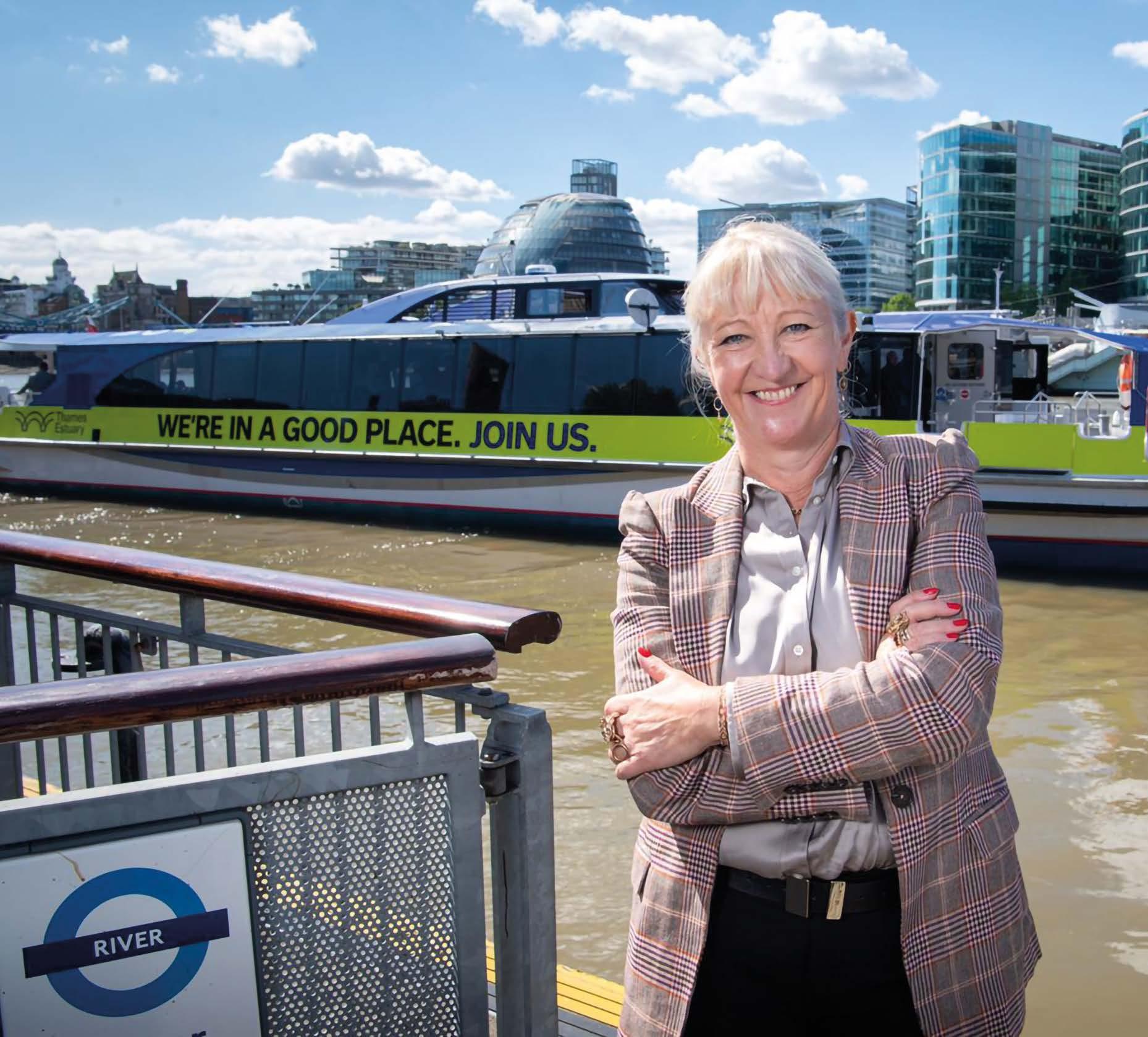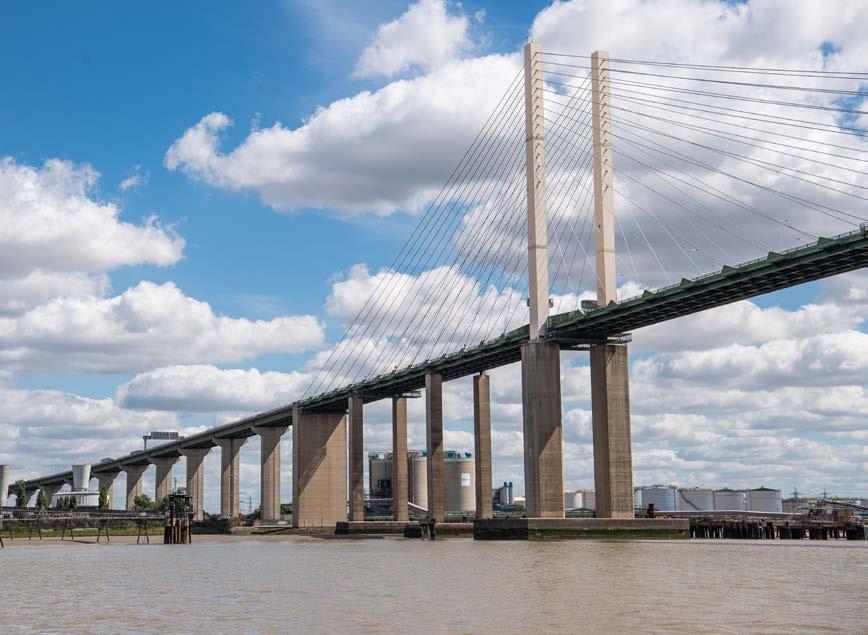
9 minute read
Thames Estuary: The Voice of the Estuary
Sustainable Business Magazine speaks to Kate Willard OBE, Estuary Envoy and Chair of the Thames Estuary Growth Board, about delivering on a region’s promise, green growth, and working with a variety of small and large stakeholders.

Advertisement
The River Thames – the longest river entirely in England – is one of the world’s best-known, stretching over 210 miles from its source in the Cotswolds, through London, before eventually spilling out into the North Sea. This site of this confluence is known as the Thames Estuary, a region covering North Kent, South Essex, East London, and the City of London.
In March 2016, the Thames Estuary 2050 Growth Commission was established, with the purpose of developing an ambitious vision for growth in the Thames Estuary Region, to unleash the latent economic potential of the region. In June 2018, the Commission published its report, and based on this report, the Thames Estuary Growth Board was established. The Thames Estuary Growth board is tasked with driving forwards the vision outlined in the report, capitalizing on the Estuary’s unique assets and unparalleled location to achieve green growth for the region and the national economy. Members of the Growth Board are working with businesses, investors, residents, and communities to make the Estuary a compelling investment proposition, and to build partnerships that transform the area.
DRIVING GROWTH
Even before any of the report’s findings have been implemented, the Thames Estuary is a thriving hub for import and export, supplied with excellent transport links, vibrant culture, and areas of natural beauty. “The lesson of the 2018 Growth Report, and from the government’s response the following year, is that we’ve got here a coherent and credible economic geography across the Estuary, one that stacks up in terms of opportunity,” explains Kate Willard OBE, Chair of the Thames Estuary Growth Board. “The world has heard of the Thames and of London. This is a capital city, and a world-class iconic river; and we’re looking for those post-transition trade links. The Estuary is also full of thriving and dynamic, often green, businesses. We’ve got great green spaces, and it’s got lots of opportunity. We have space for new homes, new communities, for culturally and digitally connected activities. The area is recognized and backed by government and by businesses as a place we need to see great green growth, and it’s the job of the Thames Estuary Growth Board to make sure that’s delivered over these forthcoming years.”
The Growth Board also recognizes the importance of ‘levelling up’ the Estuary, as Ms. Willard explains. “We want to drive fair and equitable growth across the region by investing in up-skilling opportunities and creating quality jobs, to eliminate uneven pockets of deprivation and ensure no communities are left behind.”
THE GREEN BLUE
Last year saw the launch of the Growth Board’s action plan, titled ‘The Green Blue’ in reference to the water of the Thames and to the Board’s ambition to achieve growth in a sustainable way, working with the natural environment. “Across the world, growth zones tend to talk about themselves in similar ways: a great place to do business, with lots of skilled workers, sustainable energy, lots of land – it’s a lot of generic statements,” says Ms. Willard. “There’s nothing wrong with that, but the world is a very competitive place, and distinctiveness is therefore both useful and important. We’ve got an extraordinary distinctiveness: our relationship between the Thames, and land and communities which abut the Thames, including to the west with London and to the east with the rest of the world. It’s a part of the world that also covers two other important groupings: the City of London Corporation, which very much sees us as part of the Estuary, so that’s a financial powerhouse driving us; and the river itself, through the Port of London Authority.”
As part of their action plan, the Growth Board is spearheading the development of a water-based, green-energy-based

ecosystem across the Estuary. “Our plans are based not only on land, water, or skills, but the irresistible and very distinctive combination of powerful water close to powerfully connected land,” explains Ms. Willard. “The Thames is often described as a barrier to growth in South Essex and North Kent; we completely see it as the reverse: the Thames is the opportunity, and the beating life-blood of the growth opportunity for this area. For instance, we’re looking at shifting freight off roads, and putting it onto the river, and we’re working with the Port of London Authority to see how we can clean the vessels involved. To do so, we’re absolutely sure that hydrogen will have a role to play, because there’s market demand, and an irresistible need for it in light of the zero-carbon, and clean-air agenda. Hydrogen infrastructure is also a really good example of something it would be very difficult to do at a local authority level, or a single business level, or a single location level. Something of that scale needs a strategy covering the Estuary itself, working for all end-users.”
ACTION FIRST
As it works towards its goals, the Growth Board is wary of becoming all talk, no action. “We want to fulfil our aim of being a ‘doing board’,” says Ms. Willard. “In December, we held a hydrogen summit, bringing together experts and stakeholders from across the UK, to set out a roadmap for delivering a hydrogen infrastructure. The aim of the summit was to bring the potential for hydrogen in the Thames Estuary to life. And we’re doing just that. In February, we appointed Ikigai, supported by DNV GL, to deliver a hydrogen investment strategy. Ikigai and DNV GL will evaluate and identify the potential for investable hydrogen generation, distribution, storage and usage infrastructure within the Estuary, helping us to meet the commitments made in our ambitious action plan ‘The Green Blue’.”
Another point set out in The Green Blue is delivering a world-class digital infrastructure. The Growth Board is already making headway, hiring strategic advisory firm MediaLink to handle a through-the-line analysis of the region’s digital landscape. Their work will support an explosion of development across the media, production, entertainment, leisure, energy, housing, river crossing, river freight, and education sectors.

COMMUNITY TOUCH
The Growth Board looks to increase opportunity within the region while also ensuring plans meet the needs of communities and businesses. “One of the things we work hardest on is managing those relationships at an Estuary level,” says Ms. Willard. “Especially during COVID-19, and in a post-transition economy, our ability to understand what businesses really need, how people move around, and how our towns and smaller communities function is all going to be really important. As for who those communities are, we’d never say this town is in or out, or attempt to draw a political red line on a map. If there are towns, communities or businesses that see themselves as part of the Estuary because they have a relationship with the river, then as far as I’m concerned, they are part of the Estuary.”
Representing such a broad coalition of voices has its challenges, but the Growth Board is confident that the time is right to achieve real progress. “There have been previous iterations of a Thames Estuary Growth Board, but the thing that’s always fallen apart is that the Estuary has never pulled together as one. It’s been apparent in concept, but it’s not been apparent in reality; when it comes to discussion, people have retrenched into their local mindset. What we’ve got here, however, is a really extraordinary moment in time during which political partners, private sector partners, government, local authorities, statutory bodies, and others have come together and said: ‘We’re going to fight and champion for the Estuary.’ That recognizes that at times people come from wherever they come from, they represent what they represent, and work in whatever sector they work in. But there’s a togetherness, and people are right behind it.”


CHAMPIONING SUSTAINABLE BUSINESSES
To support and champion good, green growth across the region, the Growth Board is seeking out ‘Estuary Visionaries’, who can showcase the best of sustainable business and kickstart activity across the region. “Visionaries is all about championing those brilliant businesses across the Estuary who are doing great, green stuff,” explains Ms. Willard. “That could be at all sorts of levels. It could be small businesses working with recycled materials, it could be huge airports, or big multinationals. We’re going to be talking to all our Visionaries, and as we build this campaign and build more and more of them, we’ll be talking about how we can help them. That might be helping them to talk to government about policy; it might be about funding; or about sectoral grouping, so that we can have clustering effects across the Estuary for some of this visionary activity. It’s an opportunity to share best practices, and to help all businesses plug-in to the growth agenda.”
WINNING FREEPORT STATUS
In the Chancellor’s March budget, Rishi Sunak announced the Thames Estuary as one of the locations to be granted freeport status. Freeports are zones where normal tax and customs rules are changed to encourage economic activity. They offer wider benefits for businesses such as planning reforms, funding for infrastructure improvements and innovation incentives.
“We are absolutely delighted to have been selected as a freeport location. We believe that the Thames Estuary is the right place to have freeport status, and are so pleased that the government thinks so too,” says Ms. Willard. “We tirelessly lobbied government and campaigned to show our support for the Thames Freeport, as we know just how beneficial it will be to our region, especially to those who need it most.Getting a freeport is an essential part of the Estuary’s recovery and will help it to level-up at this crucial moment in time, post-Brexit and post-Covid. The Thames freeport will unlock £400 million of port investment in deprived areas and create more than 25,000 quality jobs, with significant investment in upskilling opportunities.”
“This is a real triumph for the Thames Estuary, and one which will help us fulfil our action plan, The Green Blue, which sets out our steps to fulfilling the huge, untapped potential of the region,” says Mr. Willard. “A key part of our action plan is to champion good, green growth – that means sustainable, economic growth that works as one with our environment and natural resources, never against them. The Thames Freeport is vital for this.”






